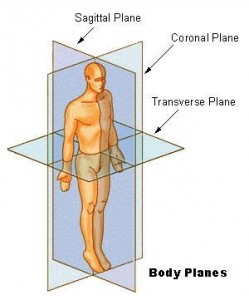Something I feel very passionate about is multi-planar training. Ever since I tore my ACL a year and a half ago, learned more about principles of rehabilitation and injury prevention, and got certified as a Corrective Exercise Specialist, I have a message about training: Thou must train in multiple planes of motion. Most people (especially endurance athletes) overtrain in the sagittal plane (front and back). This leads to overuse injuries as well as weakness and instability when a demand from the frontal (side) or transverse (rotational) plane challenges them. Which happens frequently, because we don’t move only front and back- we step to the side, we twist, we cross our legs over, et cetera. If we move in multiple planes, we need to train in multiple planes.
What is multi-planar training? Multi-planar training means training in all planes of motion.
What are the planes of motion?
- The sagittal plane means to the front and to the back. Examples: walking, running, biking, seated row, bicep curl, push ups.
- The frontal (or coronal) plane means to the sides (confusingly enough). Examples: side shuffles, jumping jacks, lat pull down, lateral raises.
- The transverse plane means rotation. Examples: Russian twists, cable woodchops, lunge w/med ball twist, golf swing.

ACL injury prevention and multi-planar training
Mike Boyle, one of the top strength and conditioning experts around and owner of the #1 Strength and Conditioning Facility in the nation (2009) as voted by Men’s Health, wrote a very interesting article on ACL injury prevention. Read it here: http://www.strengthcoach.com/public/1641.cfm?sd=51
He agreed that increasing the eccentric control (a.k.a. deceleration) from multiple planes of motion is key to reducing the incidence of ACL injuries. He describes his program in total as:
– Active Warm-up
– Power and Stability / Eccentric Strength=landing skills
– Strength Development – (emphasis on 1 Leg)
– Change of Direction Concepts – learning how to stop
– Change of Direction Conditioning – developing conditioning
His unique assertion is that this program does not differ inherently from a good training program for any athlete. Any well-developed program should include the elements listed above. In essence, there is no such thing as an ACL injury prevention protocol. There is only good training (that would naturally include multi-planar training) and bad training.
How to modify exercises in different planes? Okay, so you would like to incorporate more multi-planar training into your workouts. How do you do that? All you have to do is understand the planes of motion, and tweak your exercises to follow the various planes. The number of exercises that can be created is ENDLESS. Use your creativity! Let’s run through some examples below.
Running: Traditionally this is done in the sagittal plane. How about doing some side shuffles, running backwards, diagonal bounding, or karaoke?
Push ups: Traditionally, this is also done in the sagittal plane. How about side to side push ups? Or push ups with rotation (a.k.a. T-push ups)? (e.g. push up, then raise one arm up and twist your body laterally toward the ceiling? Then rotate back to center and repeat on the other sids)
Lunges: Again, this is usually done in the sagittal plane. How about side lunges or rotational lunges, or a multi-planar lunge matrix?
Upper Body Pull: Such as a row. Traditionally done in the sagittal plane (are you catching a pattern here?). How about a lat pull down (a pull in the frontal plane), or an alternating row with torso rotation to challenge the transverse plane?
Step Up: Do I have to say it? Usually sagittal plane dominant. How about side step ups? Cross over step ups? Transverse step ups? (Always make sure the knee is aligned over the 2nd and 3rd toe)
Does this make sense? By challenging your body in different ways and training in the way that life and all sports HAPPEN (e.g. in ALL planes), you are doing yourself a favor by promoting major injury prevention. If you don’t already train like this, start now and let me know how it goes. If you already do, I hope I have reminded you of why what you’re doing is important and reinforce your commitment to functional/multi-planar program design.
FEB

